
Story Mapping is an agile methodology specifically designed for delivering new products or features within existing product ecosystems. Developed by Jeff Patton, this approach enables customers to visualize and navigate the complete user journey required to interact with a product from initial engagement through final completion.
These tasks are strategically prioritized to maximize customer value. Nicholas Muldoon, Co-Founder of Easy Agile, characterizes this methodology as “a facilitated, curated conversation” that brings together all stakeholders to collaboratively navigate the user journey.
User story mapping serves as a strategic tool for organizations seeking to establish clarity around future product releases while preserving alignment with their existing product vision and roadmap.
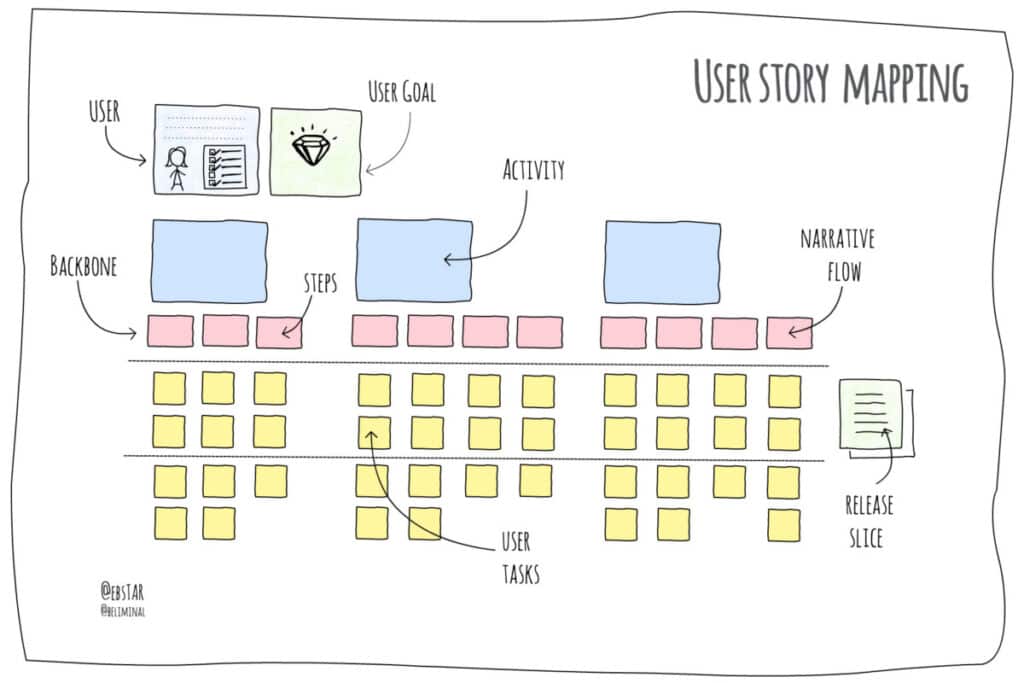
Agile user story mapping serves as a powerful methodology that delivers significant value to agile development teams. This strategic planning tool enhances the development process by enabling teams to maintain agility and respond effectively to evolving requirements and stakeholder feedback.
When developing story maps, agile teams should carefully consider the core values of the Agile Manifesto, which emphasize the critical importance of customer collaboration over contract negotiation and adaptive responsiveness to change rather than rigid adherence to predetermined plans.
These foundational values establish an optimal environment that enables teams to maintain strategic flexibility while consistently prioritizing the customer journey to deliver a viable, market-ready product.
Flat Product Backlog vs Story Mapping
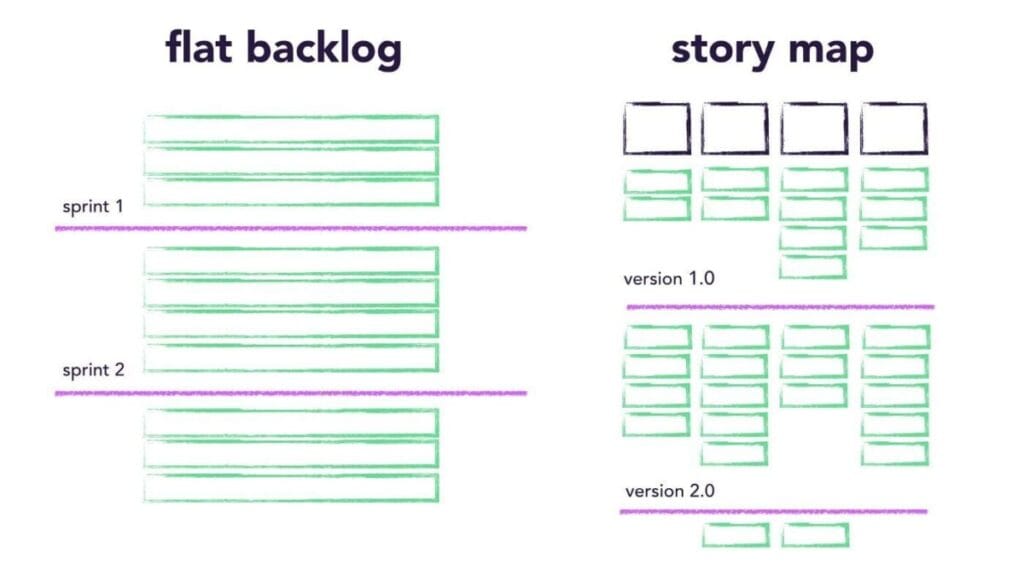
The flat product backlog represents one of the most widely adopted methodologies in agile software development. This approach functions as a prioritized inventory of deliverables designed to create customer value. Following a hierarchical structure, it organizes items in descending order of importance, with high-priority, high-value features positioned at the top and lower-priority items arranged below.
This prioritized approach enables systematic completion of tasks based on their relative importance. However, story mapping differs fundamentally from this linear methodology by contextualizing individual backlog items within the broader scope of the overall development initiative. Story mapping provides a comprehensive view of the entire product ecosystem, while a flat backlog lacks this holistic perspective.
The flat backlog approach presents significant challenges for product managers attempting to assess whether their development teams have identified all necessary user stories. Additionally, this methodology fails to provide product managers with the tools needed to effectively communicate system functionality and capabilities to stakeholders.
User story maps generate comprehensive visualizations that enable agile development teams to maintain focus on desired customer outcomes. Through this approach, agile teams can strategically identify and implement features based on customer feedback and behavior patterns while maintaining visibility into project progression. This methodology significantly reduces development waste while delivering superior outcomes for the complete product compared to traditional flat backlog approaches.
Creating User Stories
Creating effective user stories forms the foundation of successful agile story mapping and requires a systematic approach that begins with clearly defining your project goals and user needs. The most effective method for initially formatting user stories is to structure them from the user’s perspective using the widely accepted template: “As a [type of user], I want to [action] so that [benefit].” This format ensures that each story captures three critical elements: the user persona, the desired functionality, and the underlying value proposition.
This user-centric approach helps development teams maintain focus on delivering tangible value rather than getting lost in technical specifications. By consistently framing requirements from the user’s viewpoint, teams can better prioritize features based on actual user needs and expected outcomes.
Here are some comprehensive user story examples that demonstrate this approach:
- As a visitor of this site, I can type the color of the product I want in the search bar so that I can quickly find what I’m looking for without having to browse through multiple categories.
- As a returning visitor, I can have my previous search history and preferences saved so that I can easily return to products I was considering and continue my shopping journey seamlessly.
- As a mobile user, I can access a simplified checkout process so that I can complete my purchase quickly without frustration or abandonment.
- As a customer service representative, I can view a customer’s complete interaction history so that I can provide personalized support and resolve issues more efficiently.
According to Jeff Patton, the creator of user story mapping, developing a comprehensive user map involves six interconnected steps that build upon each other:
- Establish Your Idea: Begin by clearly articulating the problem you’re solving and the value you’re creating. This involves defining your target users, understanding their pain points, and establishing measurable success criteria.
- Create the Big Picture: Develop a high-level overview of the entire user journey from initial awareness through final goal completion. This step involves mapping out all the major touchpoints and interactions users will have with your product.
- Explore: Dive deeper into each section of the user journey to identify specific user needs, potential obstacles, and opportunities for enhancement. This exploration phase often reveals hidden requirements and edge cases.
- Develop a Release Strategy: Prioritize features and functionality based on user value, technical complexity, and business objectives. This involves creating a roadmap that delivers value incrementally while building toward the complete vision.
- Develop a Learning Strategy: Establish mechanisms for gathering user feedback, measuring success metrics, and validating assumptions. This includes defining key performance indicators and planning for iterative improvements.
- Have a Development Strategy: Create a technical approach that supports agile development practices, including sprint planning, resource allocation, and quality assurance processes.
The crucial first step in this process involves developing a strong backbone for your story map. This backbone consists of high-level tasks or features that describe the complete user journey from beginning to end. Think of the backbone as the main storyline that connects all user interactions in a logical sequence. For example, in an e-commerce application, the backbone might include: “Discover products → Evaluate options → Make purchase decision → Complete transaction → Receive confirmation.”
These foundational steps create the essential building blocks for producing a truly collaborative approach to story mapping. When teams work together to develop this backbone, they establish a shared understanding of the user experience and create a framework for more detailed planning. This collaborative foundation ensures that all stakeholders—from developers and designers to product managers and business analysts—have a unified vision of what success looks like and how to achieve it systematically.
Video Guide on How to do User Story Mapping:
Video Guide on User Story Mapping (Helping Agile Product Owners Manage Their Product Backlogs)
Walking Skeleton
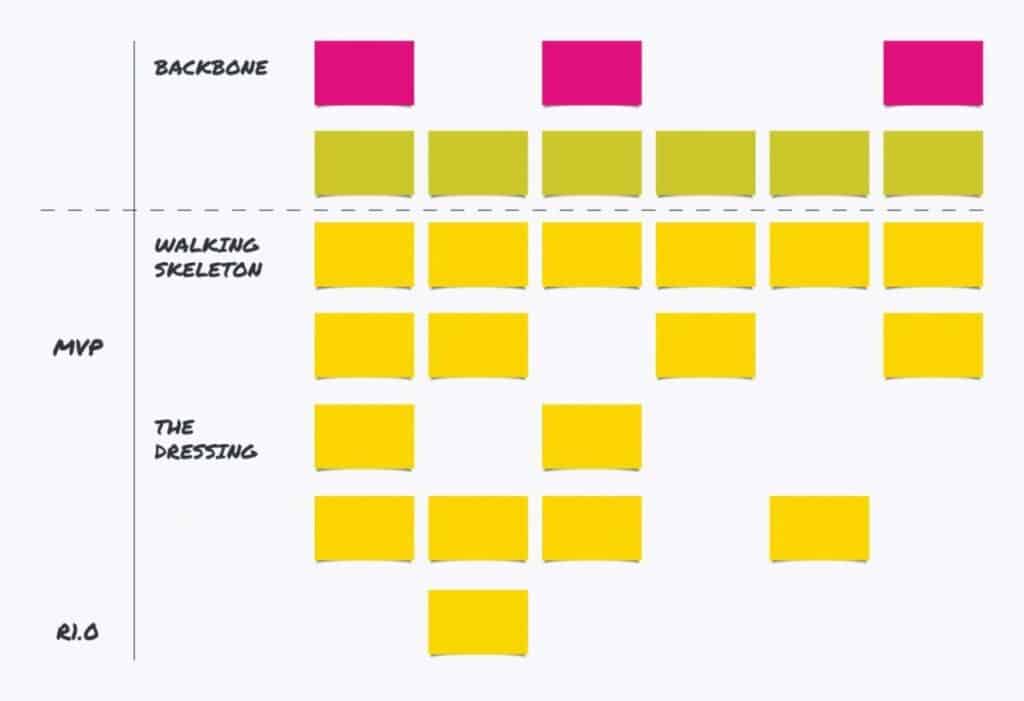
The walking skeleton represents the foundational element of a user story and serves as a critical component within a comprehensive story map framework. It delivers a clear visual representation and detailed description of the core components required to launch a market-ready product. These stories provide users with essential functionality and define the key tasks they can execute within the product ecosystem.
This foundational set of stories establishes the product’s minimum viable functionality and is synonymous with minimum marketable features (MMF). When integrated with complementary elements such as the backbone structure and supporting user stories positioned below it, the walking skeleton enables teams to construct a complete and coherent story map.
INVEST Criteria
Creating and assessing the quality of a user story in the initial story map is traditionally done through the INVEST criteria. If there is any part of a story that does not meet any of the criteria, it would be important for the story to either be readjusted or reworded.
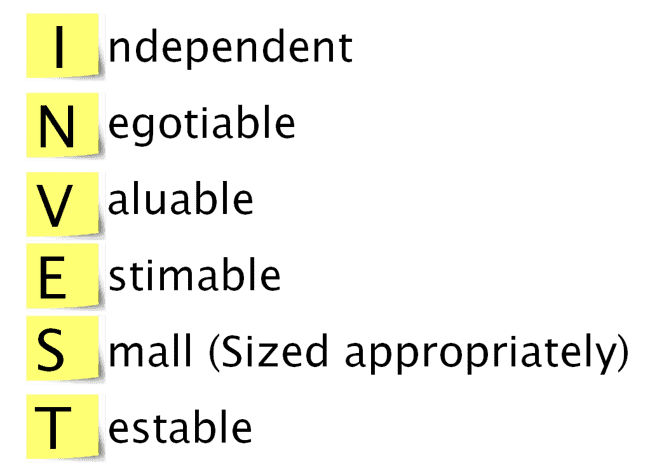
- Independent: Each user story should represent standalone business value and be capable of delivering that value independently, even if released in isolation from other stories.
- Negotiable: The implementation approach for each story should remain flexible and open to discussion among all stakeholders. This negotiation process can occur between the product owner and customer, product owner and development team, or involve additional stakeholders as needed.
- Valuable: Every story must deliver meaningful value to a specific user type or stakeholder, ensuring that development efforts contribute directly to user satisfaction and business objectives.
- Estimable: Stories should contain sufficient detail and clarity to enable accurate sizing and effort estimation, allowing teams to make informed commitments and develop realistic implementation plans.
- Small: User stories should be appropriately sized to fit within a single sprint iteration, promoting manageable development cycles and consistent delivery cadence.
- Testable: Each story must include clear acceptance criteria that enable the entire team to verify completion with precision, ensuring quality standards are met and story objectives are fulfilled.
3 C’s in User Stories
Establishing a systematic approach to creating user stories is essential for successful agile development. The most widely adopted methodology is the Three C’s framework, originally developed by Ron Jeffries in “Extreme Programming Installed.” This framework encompasses three fundamental components: Card, Conversation, and Confirmation. Jeff Patton provides additional insights into this methodology in his presentation at FlowCon.
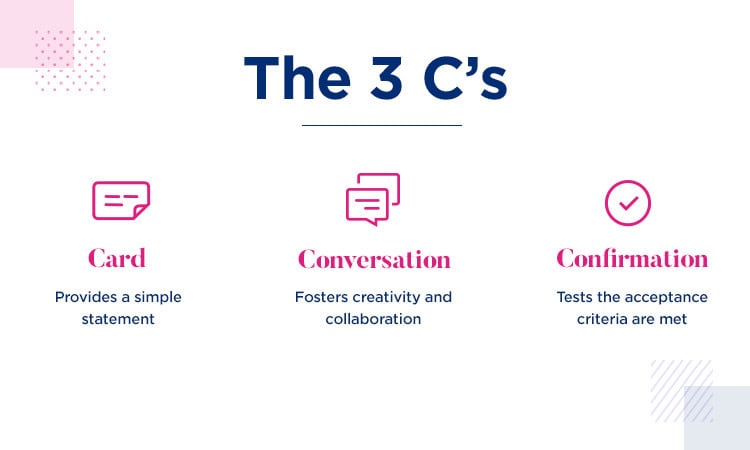
Card
The Card component of the Three C’s framework involves creating a written description of a user story that serves as a planning artifact. This collaborative process begins with capturing ideas from all team members on physical or digital mediums such as cards, sticky notes, or whiteboards, which facilitates the initial drafting phase.
This brainstorming exercise encourages team members to contribute any relevant information, including potential story titles and functional requirements. It is essential that stories are written from the user’s perspective, creating clear statements of value and intent—a practice known as expressing the “user voice.”
Conversation
The Conversation phase focuses on collaborative discussion to explore ideas and develop comprehensive solutions. During this critical process, teams must address the fundamental questions of who, what, and why for each story. The product owner bears primary responsibility for providing clear answers to these questions during planning sessions, ensuring the entire team maintains alignment toward common objectives.
Confirmation
The Confirmation stage involves documenting the technical specifications of each story while validating that its execution delivers the intended value. This phase requires establishing a unified team consensus regarding what should be built, and this agreement must be formally recorded to maintain accountability and clarity throughout the development process.
Advantages and Mistakes in Agile Story Mapping
Benefits
Story mapping offers significant advantages within agile development processes. This methodology enables all development team members to comprehensively understand the application’s architecture, particularly identifying the most complex components. Additionally, story mapping provides teams with a holistic visual representation of the product, addressing a frequent concern among agile teams regarding fragmented perspectives. Through this approach, teams gain clear visibility into how individual components integrate within the broader system architecture.
A key benefit of user story mapping is its ability to guide teams in prioritizing development efforts. For instance, when developing a website, if user journey analysis reveals that visitors frequently engage with specific sections (such as particular areas of an “About” page) more than other pages, teams can strategically prioritize the development of these high-engagement areas to maximize user value and business impact.
Mistakes
Product managers must remain vigilant about common pitfalls that can undermine the effectiveness of story mapping initiatives. One significant mistake involves engaging with customers who lack sufficient familiarity with the product or its intended use cases. Successful story mapping requires input from knowledgeable stakeholders who can provide informed perspectives on user needs and business value. Working with unfamiliar customers can lead to misaligned priorities and poorly defined requirements that fail to address actual user pain points.
Another critical error is failing to maintain consistent visibility of the story map throughout the development process. The story map serves as a strategic reference point that keeps the entire team aligned on the product vision and user journey. When teams lose sight of this comprehensive view, they risk becoming siloed in individual tasks, losing track of overarching objectives, and delivering fragmented solutions that fail to create cohesive user experiences.
Tools for Creating an Agile Story Map
Finding the right tools is vital to creating an agile story map. Jira is considered one of the most useful tools for developing the map. Here is a list of mapping programs that integrate with Jira:
1. Easy Agile
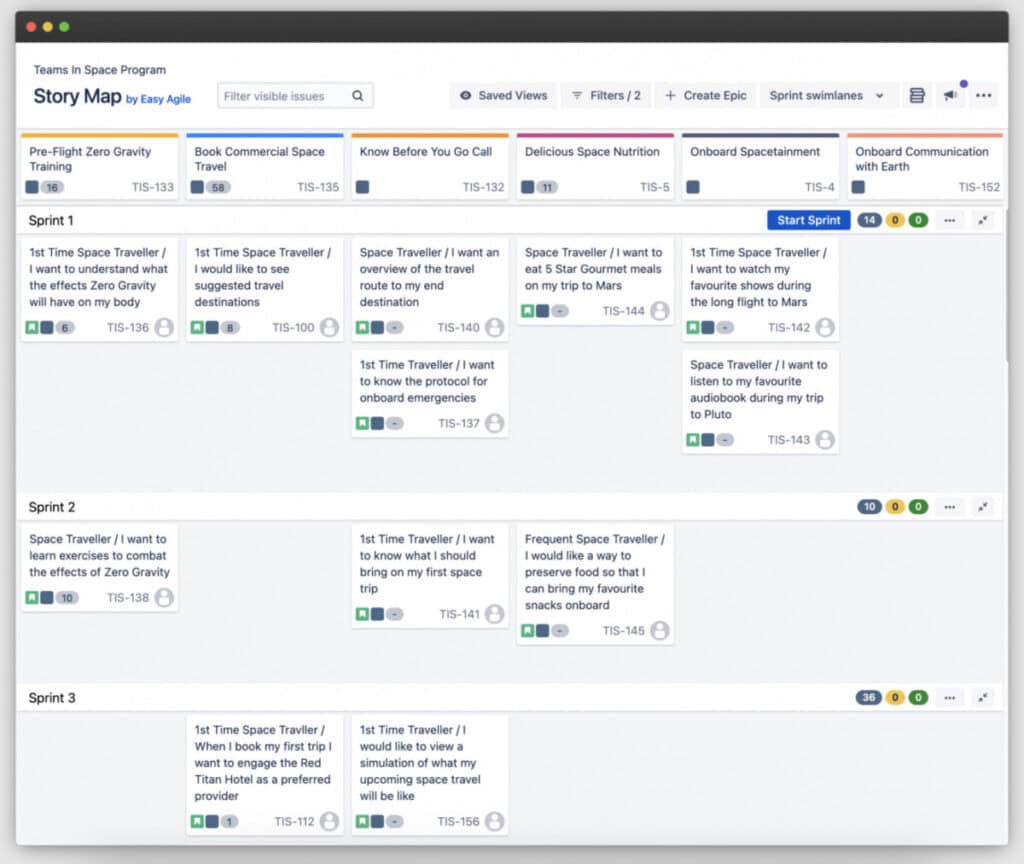
2. Bauer
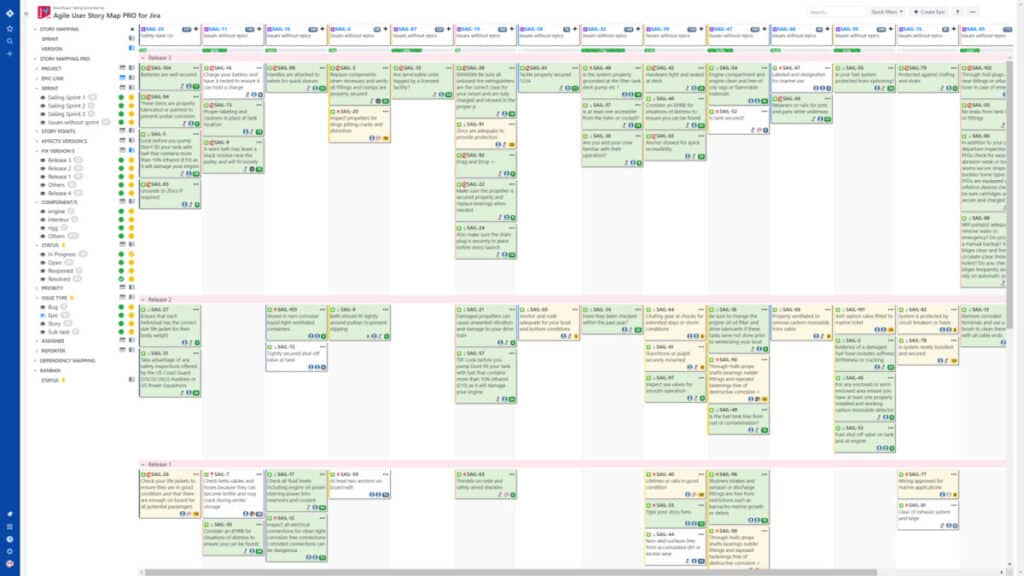
3. StoriesOnBoard
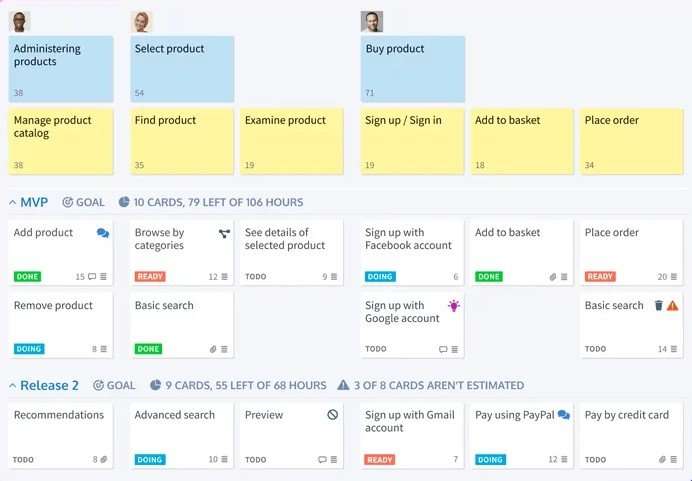
4. Cardboard
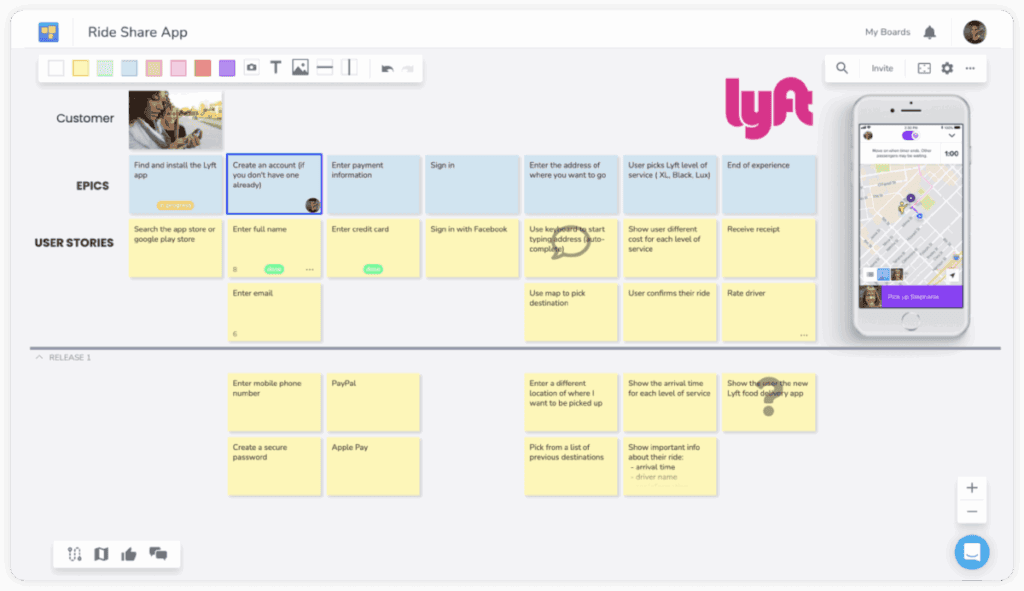
5. FeatureMap
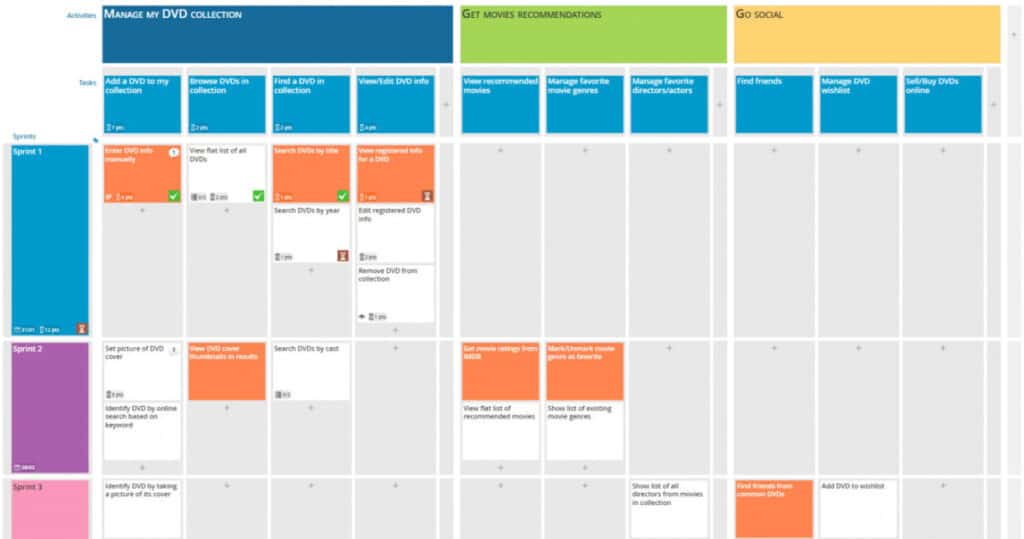
Conclusion: Charting a Clear Path with Agile Story Mapping
Agile Story Mapping, as conceptualized by Jeff Patton, stands as a powerful antidote to the limitations of traditional flat product backlogs, offering a holistic and user-centric approach to product development. By visualizing the entire user journey and contextualizing individual user stories within a comprehensive framework, teams gain unparalleled clarity, foster collaborative understanding, and maintain strategic alignment.
This methodology, rooted in the core values of the Agile Manifesto and guided by principles like the INVEST criteria and the Three C’s, empowers development teams to prioritize features that deliver tangible customer value, respond effectively to evolving requirements, and ultimately launch successful, market-ready products. Embracing story mapping is not merely about organizing tasks; it’s about cultivating a shared vision, fostering continuous learning, and consistently delivering exceptional user experiences.
FAQs on Agile Story Mapping
1. How does Agile Story Mapping fundamentally differ from a traditional flat product backlog?
Agile Story Mapping provides a holistic, visual representation of the entire user journey, contextualizing individual user stories within the broader product ecosystem. In contrast, a traditional flat product backlog is a linear, prioritized list of deliverables that often lacks this comprehensive perspective, making it challenging to understand the overall system functionality and how individual tasks contribute to the complete user experience.
2. What are the key benefits of using Agile Story Mapping for product development?
Agile Story Mapping offers several key benefits, including enhanced clarity and shared understanding as all stakeholders gain a clear, visual overview of the product and user journey. It also leads to improved prioritization, allowing teams to strategically prioritize features based on user value and business impact. Furthermore, it fosters greater adaptability, enabling teams to respond effectively to evolving requirements and stakeholder feedback, and contributes to reduced waste by focusing on desired customer outcomes. Finally, it facilitates better communication of system functionality to all stakeholders.
3. What is the “Walking Skeleton” in the context of story mapping, and why is it important?
The “Walking Skeleton” refers to the foundational set of user stories that represent the minimum viable functionality required to launch a market-ready product. It’s crucial because it establishes the core components and essential tasks users can perform, providing a clear visual representation and description of the product’s initial offering. When combined with the backbone and supporting user stories, it forms a complete and coherent story map.
4. How do the INVEST criteria contribute to effective user stories in story mapping?
The INVEST criteria (Independent, Negotiable, Valuable, Estimable, Small, Testable) are a set of guidelines used to assess the quality of user stories. Adhering to these criteria ensures that each story is well-defined, manageable, and contributes meaningfully to the product. For example, an “Independent” story can deliver value even if released in isolation, while “Testable” stories have clear acceptance criteria for verification, leading to more robust and valuable development efforts.
5. What are some common pitfalls to avoid when implementing Agile Story Mapping?
Two common pitfalls to avoid in Agile Story Mapping are engaging with unfamiliar customers and failing to maintain consistent visibility of the story map. Seeking input from stakeholders who lack sufficient product knowledge can lead to misaligned priorities and poorly defined requirements, making it crucial to involve knowledgeable customers and users. Additionally, the story map should be a living document that the entire team regularly references; losing sight of it can lead to fragmented efforts, a loss of the overarching product vision, and incoherent user experiences.
Suggested articles:
- 7 Essential Quality Acceptance Criteria Examples
- 7 x High Quality of Deliverables Examples
- Stakeholder Cube Templates & Examples
Shane Drumm, holding certifications in PMP®, PMI-ACP®, CSM, and LPM, is the author behind numerous articles featured here. Hailing from County Cork, Ireland, his expertise lies in implementing Agile methodologies with geographically dispersed teams for software development projects. In his leisure, he dedicates time to web development and Ironman triathlon training. Find out more about Shane on shanedrumm.com and please reach out and connect with Shane on LinkedIn.